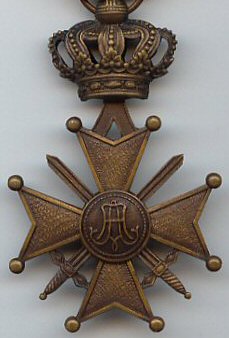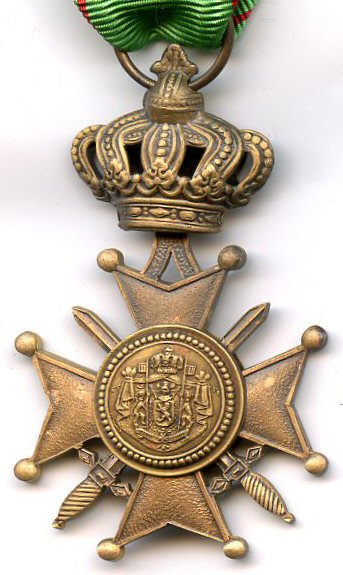Oorlogskruis with Palm.jpg on:
[Wikipedia]
[Google]
[Amazon]
The ''Croix de guerre'' ( French) or ''Oorlogskruis'' (



 The
The


Croix De Guerre, Belgium
(Dutch)
Les Décorations belges officielles de la première guerre mondiale
(French)
(In French)
(In French)
(In French and Dutch) {{Belgium honours 1915 establishments in Belgium Orders, decorations, and medals of Belgium * Courage awards Awards established in 1915 Awards established in 1940 Awards established in 1954
Dutch
Dutch commonly refers to:
* Something of, from, or related to the Netherlands
* Dutch people ()
* Dutch language ()
Dutch may also refer to:
Places
* Dutch, West Virginia, a community in the United States
* Pennsylvania Dutch Country
People E ...
), both literally translating as "Cross of War", is a military decoration of the Kingdom of Belgium established by royal decree
A decree is a legal proclamation, usually issued by a head of state (such as the president of a republic or a monarch), according to certain procedures (usually established in a constitution). It has the force of law. The particular term used for ...
on 25 October 1915. It was primarily awarded for bravery or other military virtue on the battlefield. The award was reestablished on 20 July 1940 by the Belgian government in exile
The Belgian Government in London (french: Gouvernement belge à Londres, nl, Belgische regering in Londen), also known as the Pierlot IV Government, was the government in exile of Belgium between October 1940 and September 1944 during World W ...
for recognition of bravery and military virtue during World War II
World War II or the Second World War, often abbreviated as WWII or WW2, was a world war that lasted from 1939 to 1945. It involved the vast majority of the world's countries—including all of the great powers—forming two opposing ...
. The post-1940 decoration could also be awarded to units that were cited. The decoration was again reestablished by royal decree
A decree is a legal proclamation, usually issued by a head of state (such as the president of a republic or a monarch), according to certain procedures (usually established in a constitution). It has the force of law. The particular term used for ...
on 3 April 1954 for award during future conflicts.
World War I

Award statute
TheWorld War I
World War I (28 July 1914 11 November 1918), often abbreviated as WWI, was one of the deadliest global conflicts in history. Belligerents included much of Europe, the Russian Empire, the United States, and the Ottoman Empire, with fightin ...
''Croix'' de guerre was established by royal decree
A decree is a legal proclamation, usually issued by a head of state (such as the president of a republic or a monarch), according to certain procedures (usually established in a constitution). It has the force of law. The particular term used for ...
on 25 October 1915 as an award for bravery or other military virtue on the battlefield. It was only awarded to individuals. The ''Croix de guerre'' was not only awarded for bravery but also for three years or more of service on the front line, or for good conduct on the battlefield. It was also awarded to volunteers older than 40 or younger than 16 after a minimum of 18 months of service, to escaped prisoners of war rejoining the armed forces, and to military personnel who were placed on inactive duty because of injury.
Award description
The World War I ''Croix de guerre'' was a 40mm wide bronze Maltese cross with 3mm in diameter balls at its eight points. It had a 14mm in diameter central medallion bearing the relief image of a "lion rampant
The lion is a common charge in heraldry. It traditionally symbolises courage, nobility, royalty, strength, stateliness and valour, because historically the lion has been regarded as the "king of beasts". The lion also carries Judeo-Chr ...
" on its obverse
Obverse and its opposite, reverse, refer to the two flat faces of coins and some other two-sided objects, including paper money, flags, seals, medals, drawings, old master prints and other works of art, and printed fabrics. In this usage, ...
and the royal cypher of King Albert I on its reverse. Two 37mm long crossed swords point upwards between it arms. A 14mm high "inverted V" between the two points of the top cross arm is secured to the inside of a 25mm wide by 25mm high royal crown, the ribbon's suspension ring passes through the top orb of the crown giving the cross a total height of 65mm.
The ribbon of the World War I ''Croix de guerre'' is red wide, with five wide light green longitudinal stripes, three at the center separated by and one on each side 3 mm from the edges.
When the person being awarded the ''Croix de guerre'' was mentioned in despatches, this distinction was denoted by a device worn on the ribbon, either a small lion or a palm adorned with the monogram "A" (for Albert I):
*Bronze lion: regimental level
*Silver lion: brigade level
*Gold lion: divisional level
*Bronze palm: Army level
*Silver palm: five bronze palms
*Gold palm: five silver palms
When awarded posthumously, the ribbon of the ''Croix de guerre'' was adorned with a narrow black enamel bar.
World War II
Award statute


 The
The World War II
World War II or the Second World War, often abbreviated as WWII or WW2, was a world war that lasted from 1939 to 1945. It involved the vast majority of the world's countries—including all of the great powers—forming two opposing ...
''Croix de guerre'' was established on 20 July 1940 by the Belgian government in exile
The Belgian Government in London (french: Gouvernement belge à Londres, nl, Belgische regering in Londen), also known as the Pierlot IV Government, was the government in exile of Belgium between October 1940 and September 1944 during World W ...
, it differed from the World War I version in its statute and slight changes to the reverse of the central medallion and the ribbon.
It was still mainly awarded to individuals, but was now also authorized as a unit award. A war cross being presented to a unit was denoted by a ribbon of the war cross being affixed to the unit colours
Color (American English) or colour (British English) is the visual perceptual property deriving from the spectrum of light interacting with the photoreceptor cells of the eyes. Color categories and physical specifications of color are associ ...
The Belgian ''fourragère
The ''fourragère'' () is a military award, distinguishing military units as a whole, in the form of a braided cord. The award was first adopted by France, followed by other nations such as the Netherlands, Belgium, Portugal, and Luxembourg. Fou ...
'' was awarded by the Belgian Government to a unit that was cited twice. Award of the fourragère was not automatic and required a specific decree of the Belgian Government. The ''fourragère'' is in the same colours as the ribbon of the World War II ''Croix de guerre''. The Belgian ''fourragère'' was only worn by those who were members of the unit at the time of the award.
Award description
The World War II ''Croix de guerre'' was constructed in the same dimensions as its World War I predecessor, the only real difference being the royal cypher ofKing Leopold III
Leopold III (3 November 1901 – 25 September 1983) was King of the Belgians from 23 February 1934 until his abdication on 16 July 1951. At the outbreak of World War II, Leopold tried to maintain Belgian neutrality, but after the German invasi ...
on its reverse. The new ribbon was still red with light green stripes but there were now six, 1mm wide, and positioned three on each side 2mm apart beginning 2mm from the edge of the ribbon.
The same ribbon devices were used as in World War I except the palms were now adorned with the monogram "L" (for Leopold III).
Post 1954 variant


Award statute
On 3 April 1954, the Belgian government re-established the ''Croix de guerre'' but this time without any reference to a specific conflict. This decoration is intended to be awarded in a manner akin the World War II statute during potential future wars. The 1954 ''Croix de guerre'' has not yet been awarded.Award description
The post-1954 (or current) ''Croix de guerre'' is similar to the previous variants but with a different reverse center medallion now bearing theCoat of arms of Belgium nl, Eendracht maakt machtgerman: Einigkeit macht stark
, orders = Order of Leopold
, other_elements = The whole is placed on a mantle Gules with ermine lining, fringes and tassels Or and ensigned with the Royal Crown of Belgium. Above ...
''in lieu'' of a royal monogram.
The ribbon is a colour reversal of the World War II ''Croix de guerre'' ribbon, green with three narrow 1mm wide red stripes 2mm apart on each side beginning 2mm from the edge.
See also
*Croix de Guerre (France)
The ''Croix de Guerre'' (, ''Cross of War'') is a military decoration of France. It was first created in 1915 and consists of a square-cross medal on two crossed swords, hanging from a ribbon with various degree pins. The decoration was first awa ...
* Croix de Guerre 1914–1918 (France)
*Croix de Guerre 1939–1945 (France)
Croix (French for "cross") may refer to:
Belgium
* Croix-lez-Rouveroy, a village in municipality of Estinnes in the province of Hainaut
France
* Croix, Nord, in the Nord department
* Croix, Territoire de Belfort, in the Territoire de Belfort d ...
* List of Orders, Decorations and Medals of the Kingdom of Belgium Belgium has established numerous orders of knighthood, decorations and medals since its creation in 1830. Below is a list of the main awards.
Orders
Order of Leopold
Order of the Crown
Order of Leopold II
Order of the African Star
Royal Or ...
References
Other sources
* Quinot H., 1950, ''Recueil illustré des décorations belges et congolaises, 4e Edition.'' (Hasselt) * Cornet R., 1982, ''Recueil des dispositions légales et réglementaires régissant les ordres nationaux belges. 2e Ed. N.pl''., (Brussels) * Borné A.C., 1985, ''Distinctions honorifiques de la Belgique, 1830–1985'' (Brussels) * Paul Hieronymussen, 1967, Orders Medals and Decorations of Britain and Europe in colour, 2nd Ed. 1970. (London)External links
Croix De Guerre, Belgium
(Dutch)
Les Décorations belges officielles de la première guerre mondiale
(French)
(In French)
(In French)
(In French and Dutch) {{Belgium honours 1915 establishments in Belgium Orders, decorations, and medals of Belgium * Courage awards Awards established in 1915 Awards established in 1940 Awards established in 1954